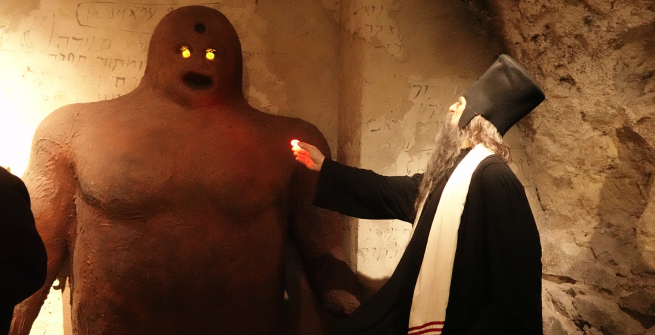Are you stuck in a monster rut? Need a broader selection of creeps and ghouls for your next campfire story or slumber party cautionary tale? When it comes to fantasy creatures, we've barely scratched the surface of what's lurking in folklore. In honor of Jewish American Heritage Month, let's explore a fascinating collection from Jewish folklore.
Golem
You may already be familiar with the Golem; the clay behemoth frequently appearing in fantasy fiction and even romantasy (a sub-genre I quite enjoy). One of my favorite renditions of the Golem legend is The Golem and the Jinni by Helene Wecker, which blends Jewish and Middle Eastern folklore in a beautifully crafted tale set in early 20th-century New York.
But the Golem's origins stretch much further back, with the concept appearing in Psalm 139:16, where "golem" refers to an "unfinished" or "embryonic" form. In medieval Jewish mysticism, rabbis experimented with creating golems using sacred letters and divine names, the most famous legend being that of Rabbi Judah Loew ben Bezalel of 16th-century Prague, who allegedly fashioned a Golem to protect the Jewish community from persecution.
Though the Golem is often seen as a guardian, many stories warn of the unintended consequences of unchecked power. This idea has influenced characters like Frankenstein's monster and even modern artificial intelligence. Fun fact: "Abracadabra" comes from avra k'davra, Aramaic for "I create as I speak."
In recent years, golems have found their way into Romantasy novels. I Made it Out of Clay by Beth Kander and Magical Meet-Cute by Jean Meltzer both play with the idea of golems as boyfriend-slash-bodyguards, a fun twist on the ancient myth. Even The X-Files [Season 4 Episode 15] tackled this legend in the episode "Kaddish," where Mulder investigates a golem linked to a murdered Jewish man.
Estries
While vampires get plenty of attention in folklore, Jewish tradition has its terrifying blood-drinkers, Estries, female Jewish vampires who shapeshift into owls. First mentioned in Sefer Hasidim, a 13th-century text, their name may stem from the French strix (night owl) or Greek striges (screech owl).
But Estries are far more than just vampires; they are pure shapeshifters, appearing as cats, crows, and owls. Unlike the vampire tropes found in mainstream horror, Estries exclusively prey on Jewish men and can fly using their hair (yes, in addition to their wings).
It's a mystery why Estries haven't received more literary attention, given how unsettling their lore is, but a fresh take on the legend appears in Night Owls by A. R. Vishny. This thrilling paranormal YA romance follows two Estries fighting through New York's monstrous underworld to save the girl one of them loves, while dodging the boy one of them fears.
Dybbuks
If ghosts are unsettling, Dybbuks take it to another level. These spirits of the dead refuse to move on, latching onto living hosts and causing havoc, often manifesting in symptoms resembling mental illness. Dybbuks can possess someone for various reasons, sometimes out of malice, sometimes as a form of revenge. The most famous Dybbuk tale appears in The Dybbuk, a 1920 play by S. Ansky, where the soul of a betrayed man possesses the body of his betrothed, making for a haunting love story rooted in Jewish mysticism.
The Dybbuk legend has inspired eerie modern tales, including The Dybbuk Box by Jason Haxton, which details the supposed real-life history of a cursed box, later adapted into the horror film The Possession (2012). Some versions suggest Dybbuks can be "trapped" inside objects, which makes the idea of them following someone home even more disturbing.
Sheydim & Mazzikin
Demons lurk in the margins of Jewish folklore, but they aren't all simply evil. Sheydim (or Shedim), sometimes viewed as "foreign gods," appear in serpent form and are often considered both dangerous and wise.
A subgroup, the Mazzikin, are invisible spirits described as winged beings capable of foretelling the future, though they are more demon than angel. Some legends claim they descend from Lilith herself, linking them to chaos and temptation. Speaking of Lilith, her influence extends far beyond folklore into pop culture. The classic 17th-century Jewish folktale that inspired Tim Burton's The Corpse Bride made its way into Lilith's Cave, a 1991 collection of Jewish supernatural stories, before finally becoming a cult-favorite film. And if you're familiar with The Sandman comics or the TV series Lucifer, you may have met Mazikeen, a fierce warrior said to be one of Lilith's children.
From protector golems to vengeful dybbuks, from owl-vampires to serpentine demons, Jewish folklore offers a treasure trove of strange and fascinating creatures—each with their own unique place in myth, legend, and modern storytelling. So next time you need a fresh monster for a ghost story or a bit of supernatural inspiration, look beyond the usual suspects—you might find something even more terrifying.
Check out this list of books for further reading and inspiration!
























